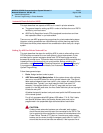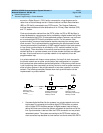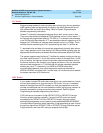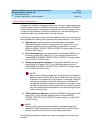
MERLIN LEGEND Communications System Release 6.1
Network Reference
555-661-150
Issue 1
August 1998
Network Management
Page 5-3General Programming in Private Networks
5
Automatic Route Selection (ARS) 5
This topic describes two aspects of ARS as it is used in private networks:
■ The general steps for setting up ARS in order to facilitate the use of PSTN
facilities by non-local users
■ ARS Facility Restriction Levels (FRLs) assigned to extensions and how
their operation differs in a private network.
There are no new ARS programming procedures for private networked systems.
However, existing procedures are used differently and the planning required for
ARS takes the whole private network into consideration rather than just a single
system.
Setting Up ARS for Private Network Use 5
This topic describes the steps for modifying ARS in order to allow calling out on
PSTN facilities connected to a non-local system in the private network. It also
provides tips for system managers whose local PSTN lines/trunks are being
accessed by remote users. This section does not summarize ARS procedures but
instead points out the factors that you must consider. Before reviewing this
information, read Chapter 2,”Call-Handling Scenarios” and Chapter 4, “Security.”
For programming procedures and details, see “Automatic Route Selection” in
System Programming
.
Follow these general steps:
1. Pools. Assign tandem trunks to pools.
2. ARS Tables and Digit Manipulation. At the system where calls originate,
use one or more ARS tables for routing private network calls. The type of
table required depends upon how users in your system will employ private
networked lines. Typically, you might need an Area Code table. For
example, if the remote system is in the 617 area code and your local
system is in the 908 area code, the Area Code Table that you set up might
include the entry
.
All tables that specify tandem trunk pools must prefix the ARS access code
of the remote system.
For all fully programmable ARS tables, ARS tables 17 & 18, Dial 0 table,
and Special Numbers table, the Remote Access code must not be
programmed in the prepended digits attributes table of each table.
CAUTION:
!
Unless private networked systems are collocated, each system
should have at least one loop-start line connected to the PSTN. The
line is required to allow connection of a power-failure telephone to the
Power-Failure Transfer (PFT) jack on a module as a power outage
backup and for correct routing of emergency and other N11 calls. To
ensure that the correct services are reached, if the loop-start line is


















